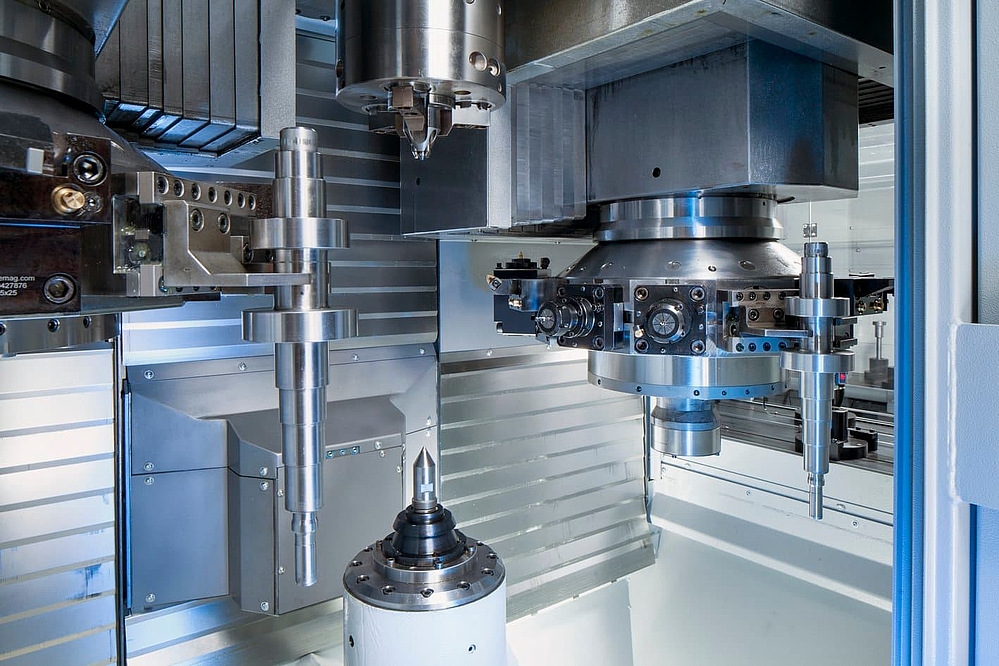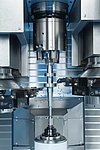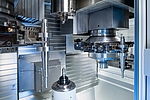03/16/2021 - Oliver Hagenlocher - Press
Vertical Turning Center for Shafts: 4-axis Machining of Rotor Shafts, Transmission Shafts and more
The VTC 200 shaft turning center delivers top performance in high-volume series shaft production.
Images
Shaft manufacturing is a core function in automotive production. While in recent years drive and transmission shafts were the main focus of production planners, the success of electromobility now also increases the demand for productive rotor shaft manufacturing. Therefore, there is a need for a manufacturing solution that is able to machine a great variety of components. All these components have one thing in common: large unit volumes and very high quality requirements. After all, the efficiency of the entire drive train depends on the quality and functionality of the shafts.
The vertical 4-axis shaft turning machines of the VT series are ideal for this task. When it comes to machining components with a maximum length of 630 millimeters and a maximum diameter of 200 millimeters, the machine is able to make full use of its qualities:
• Simultaneous: The machining process is performed with four axes, in other words simultaneously from two sides. That is why the machine is equipped with two tool turrets with twelve posts each, of which 11 can be loaded with turning tools or driven tools, one post on each turret is occupied by a workpiece gripper.
The following animation clearly explains the principle: https://www.youtube.com/watch?v=YkXrZzompOA
• Automated: The workpiece grippers handle the parallel loading and unloading of the machine. While one gripper brings a new raw part into the clamping position, the other transports the finished part out onto the workpiece conveyor. To achieve this, the VT series is equipped with circulating parts storage units from which raw parts can be picked up and into which finished parts can be deposited. The TrackMotion automation system allows for several VT machines to be interlinked easily and cost-efficiently.
The following animation shows an example of interlinking for rotor shaft machining: https://www.youtube.com/watch?v=B9pywqiPg-s
When combined, the machine’s advantages provide reduced cycle times and therefore guarantee minimal unit costs.
Machine design aimed at quality
The core of the VT machines is the machine base made from MINERALIT polymer concrete. This rigid and low-vibration basic structure houses all the technological units: a powerful working spindle, the tool turrets and the tailstock. This guarantees perfect surfaces and dimensionally accurate geometries. Furthermore, the vertical arrangement of the component, which is typical for EMAG, ensures that chips fall freely downward, which prevents chip build-up in the machine compartment. Optimal ergonomics was a priority in the machine’s design, which allows for fast retooling and perfect accessibility of all units (electrics, hydraulics, cooling), when service is required. The operator interface of the control unit has also been designed with clarity and user-friendliness in mind.
Ability to perform conventional turning and scroll-free turning
While 4-axis machining already offers tremendous performance resources for conventional turning of shaft parts, the machining speed can be further increased by implementing the scroll-free turning technology, e.g. for longitudinal turning. Whenever the clamping or the stability of the component allows it, the scroll-free turning technology allows for very high feed rates. This considerably reduces working times and the process is much faster (by a factor of 4 to 6) than a comparable longitudinal turning process. This provides users with a whole number of advantages: In addition to the already mentioned high feed rates, the tool life of the scroll-free turning tool is also very high, since the entire cutting edge is used rather than it being worn in specific areas. This turning technology allows for the highest surface quality requirements to be implemented; even scroll-free surfaces can be produced.
You can read more about scroll-free turning in this blog entry:Interview with Mr. Ruckwied
Contact

Oliver Hagenlocher
Area
Press and Communication







